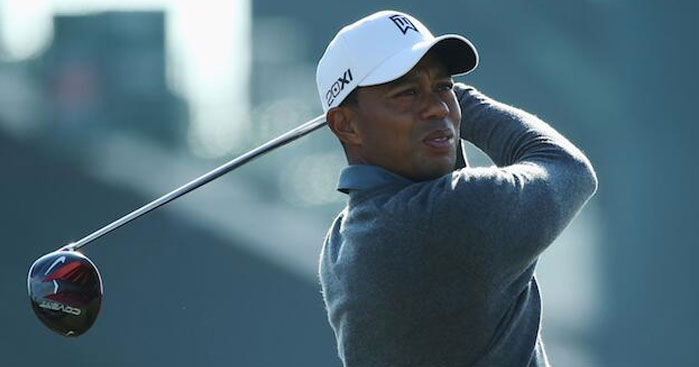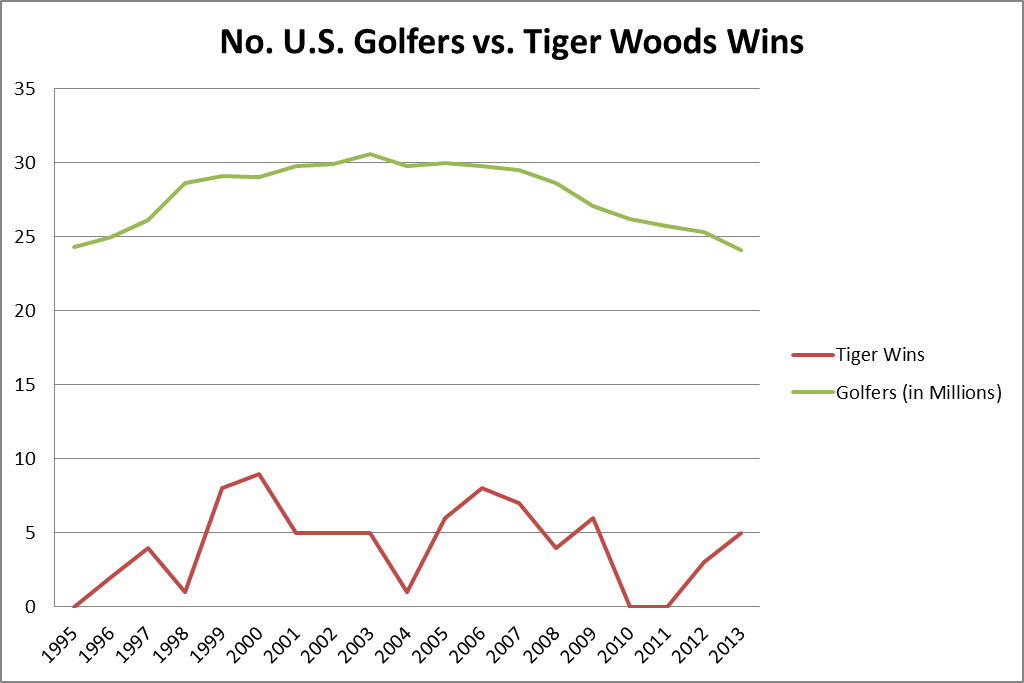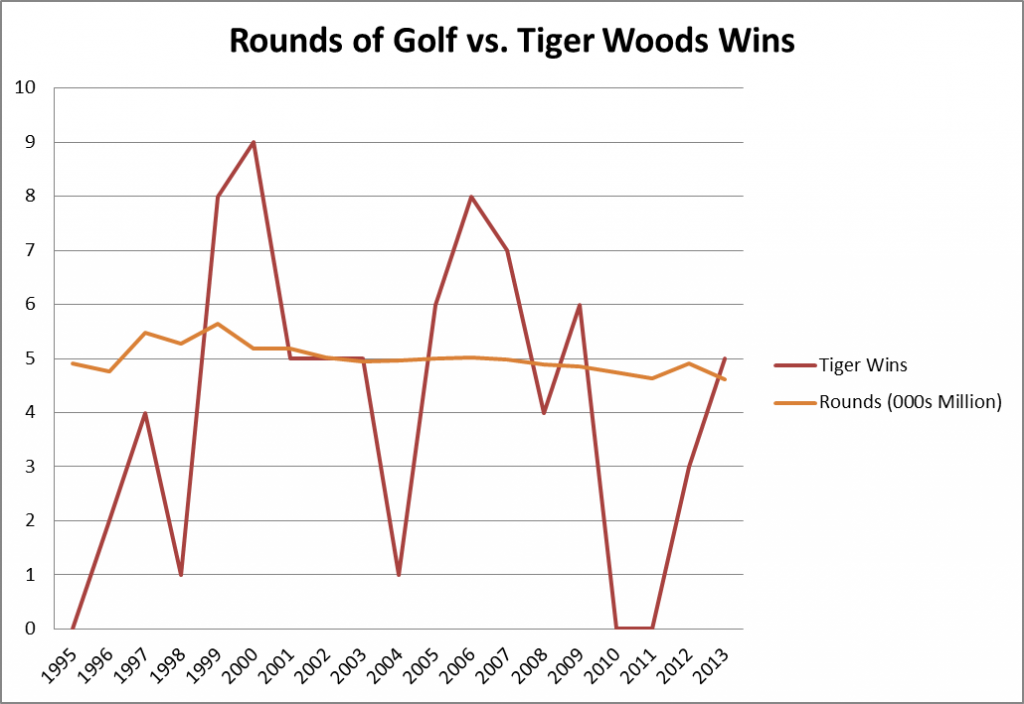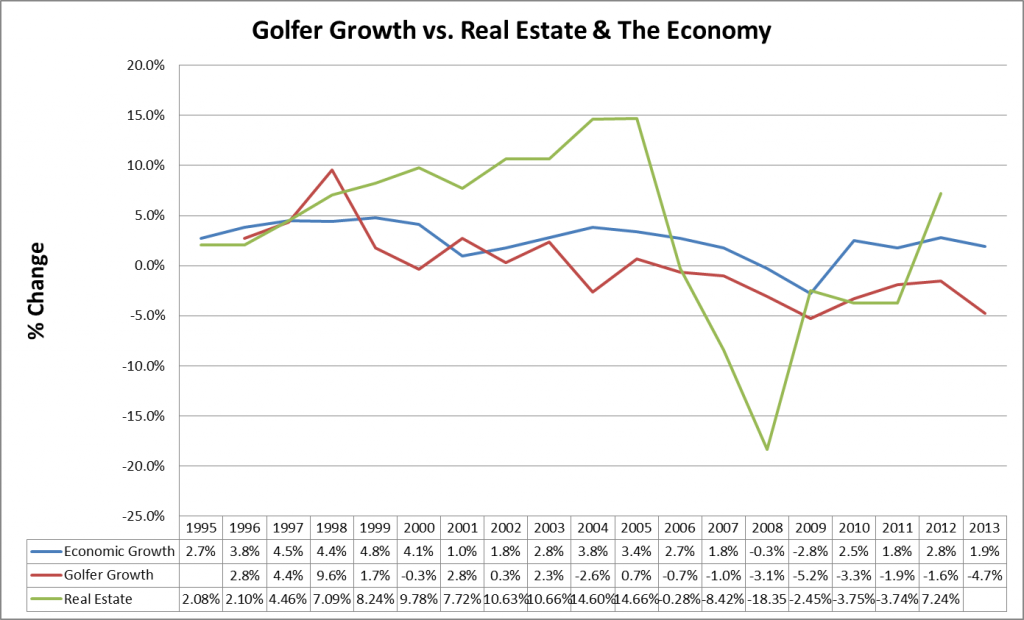Hey, remember Tigermania? It was bigger than Hulkamania. It began with Woods' breakthrough beatdown of the field in the '97 Masters and surged to its peak at the '01 Masters, when Woods finished off the historic feat of owning all four major championship titles at the same time.
A baker's dozen years later, Woods in winless in 2014 -- in fact, he has more back surgeries than victories -- a season after the former world No. 1 took home a handful of PGA Tour events. It's been six years since Woods won a major championship.
PGA Tour ratings are always lower compared to when Woods is in the field and in contention (the contention part is important). Ratings for the three majors this year have been lousy, what with Woods not playing in two of them and a lack of drama in any of them.
Meanwhile, golf participation is down some 6 million since the peak of 2005. The sport is trying to figure out why it happened and what to do to stem the tide of golfers leaving the game. There's a school of thought that's developed in some circles that golf's broader decline is directly attributable to Woods' decline. That school needs to be shut down. Historically, Woods performance had little, if any, correlation to how many people play the game recreationally. A look at a few charts make clear the evidence, but first, a logic experiment.
Do you play golf? If you do, what impacts whether or not you play on a given day? Availability is probably one. If you're working, golf is out. If it's a weekend, then it's a matter of family scheduling.
The next is having the money to play. If you're broke, you don't play. If you have cash, you might play.
What probably doesn't creep into your decision making is how well Tiger Woods is doing. He plays less than 20 times in a year, meaning he could only impact golf participation on some 80 days of the year, unless there's some kind of mystical Tiger hangover when he plays poorly. But if Woods doesn't post a top 10 on Sunday, do you cancel your tee time for next week? Would you cancel a buddy trip if Woods had to WD from a tournament? No. Of course not. Facetiousness aside, the data makes the case, so let's look at a few charts.
Let's look at the number of golfers in the United States compared to Tiger Woods wins by season.
At first glance, one might think Woods at his most prolific may have had some impact on the growth of golf in this country. The problem, then, is the impact of Woods' poor seasons on participation. The negative impact should be the same, or somewhat close. It's not.
In fact, look at Woods' performance in 2008 and '09. Woods won four times, including the U.S. Open, in 2008. In his comeback year, Woods won six times. Golf lost 1.5 million players.
In the first decade of Woods' professional career, the number of U.S. golfers jumped from 25 million to 30 million. In the ensuing years, golf has lost all of those players and then some. It's not Tiger.
So maybe Woods has nothing to do with the number of people that play golf. But does his career track have anything to do with how often golfers play? Nope. The data actually looks worse considering rounds played in the U.S. compared to Woods' career.
Over the course of Woods' professional run, the total number of golf rounds played in the U.S. has been in steady decline, going from a peak of nearly 550 million rounds in a year in the late 1990s to around 460 millions rounds per year. Looking at that data combined with the number of golfers, the sport saw a decline in the number of rounds played per year by golfer, going from nearly 21 rounds per player in 1997 to a little above 16 in 2003. The good news for the sport is that number has been steadily climbing since that trough to around 19 rounds per golfer per year now. There may be fewer players, but they play more often than at Woods' most potent.
The truth is that -- aside from demographic data -- the best indicator of golf participation is the health of the economy. If people feel good about their financial position, they're happy to play golf. If not, they won't. And the impact felt by golf participation happens in a 12-18 month lag.
So let the data put to bed any notion that golf's future hinges on Tiger Woods. Its past never did.





Add Comment